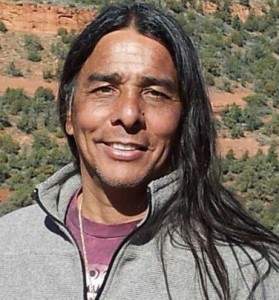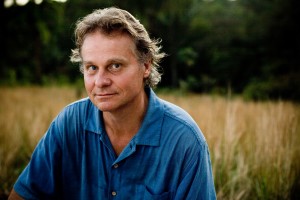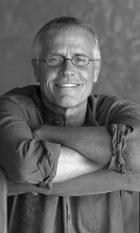Hidden Gems: Mati Waiya of Wishtoyo Chumash Demonstration Village
We are long-time teachers and native Angelenas who love to share the hidden gems in our favorite city. In this series, we interview local heroes whose passions and work inspire us.
We interviewed Mati Waiya at Wishtoyo’s Chumash demonstration village on the bluffs in Malibu overlooking the Pacific Ocean, where a stream meets the ocean. We learned how his passion and practice of traditional culture guided him to build a place that inspires, teaches, and brings peace.
Learn more at Wishtoyo.org.
What was your vision for this site?
This 8,000-year-old Chumash village site had become derelict with trash, rusted water tanks, invasive species and excess concrete blocking the water flow in the creek. Twelve years ago, I cleared a space the size of a small plate, arranged some stones into a circle, and made my first offering to ask permission from the ancestors. I came here every day, even if it was for fifteen minutes, to make my offerings and prayers. At first, I didn’t have a blueprint in my mind, but when I framed the first three houses Aps before we attached the tule reeds, It was like, “You can see it’s really going to happen!” We’ve been building for seven years, about half done.
Tell us about the early days at the Foundation.
We finally got the thatching on the first house. My wife and I slept in it. We did a ceremony, woke up
the fire; the fire illuminated the ceiling with a beautiful flame. We came outside and looked back at the
fire. It looked like a heartbeat. We thought, ‘how beautiful, this is how it was, how we lived.’ She and I
put a grill on the fire, cooked some dinner, we could hear seals bark and owls and coyotes call — it was a beautiful starry night — what a life! In the morning we picked up the door flap and you could see the whales migrating and blowing spumes. It was unreal to see this all come alive.
What do you hope children find here?
When kids come here, they get a sense of how Chumash Peoples lived in a paradise — water clean, skies clear, you could see the constellations, and your dream-time was real. You could see whales, dolphins, and grizzly bears. We in the modern world have taken all that away and one day we will regret it. Through this village and our messaging, and dance and story and song, and experience and smell and sound and sight, all these things are how we share a People’s way of life and culture. This connection to culture is what has been missing from the environmental movement.
Our stories of courage empower children with their right to be heard, to have a healthy world around them. No one has the right to take that away from you. Be heard, speak your truth. This will be your world. Maybe one day you will wish for clean energy, no fossil fuels. Our youth will be making the decisions. We must build a foundation, invest in the future we’ll never see. That’s what I believe we do here.
What could we expect at a typical school trip?
We welcome a group of 60-70 students, and break into sessions. They learn a dolphin calling song, they go into a traditional house, they see a tomol (traditional redwood plank canoe). We take them inside one of the aps (traditional round tule-thatched home) and show a power point depiction of whales, dolphin dancers, pelican flutes — how we live as a maritime people — and the impact of pollution and plastic on these resources. We show them some of our native plant restoration, and teach about endangered plants and medicine and the importance of stewarding the environment. I dress in traditional ceremonial Regalia and paint to tell a story about courage — the little kangaroo mouse looking for its courage, Red-tailed hawk and the sun, what would happen if the sun didn’t come out? I use a big drum and they feel it vibrate, I get them up to dance with me, they’re physically involved. They see the history and ceremony, fire, sounds, village, ocean, science, song, language. They don’t want to leave, and we tell them, ‘You have to go now.’
Why is Wishtoyo important?
What we offer is beyond outdoor education. Letters come back with drawings of our village and thanking us for taking the time to teach them to be good stewards of their home. We read them and know — we’re getting through to them! Our culture was almost lost. Look how meaningful it is in this time when this world is really at the verge of destruction.
A little blond child asked me, ‘Mati, how do I become an Indian?’ I told him that inside, if you love dolphins and whales and rivers and you believe these are important, it’s already in you. Children are born pure without influence and they learn by example. We send men to the moon, but here we launch prayers for healing, to remind us of the hurt and suffering going on in the world, to empower youth and innocent kids to have hope besides what they see on computers and tv.
Did you grow up in the traditional culture?
I knew about my native background from my grandmother and great grandmother and family. They were assimilated into working on Rancherias. Being “Mexican” was safer during the end of Mission times and the American campaign to get rid of Indians by any means possible. In school I learned American ways, see Dick and Jane run, white picket fence, stories about the padres being so great, learning English, getting in trouble if you speak Spanish — we learned Spanish because they took away our names and gave us Europeanized names. I also saw my mom and uncle involved in Chumash culture.
What made a difference in your life?
I was trying to be a successful contractor, had a lot of work going, but one day I realized ten years had just flown right by me, and this can’t be what life is about. I took a step back and thought about where I wanted to go. I didn’t want to put my head on my pillow at the end and think, “I didn’t live the life I could have.” I started seeing the Leave it to Beaver world was a big farce. One day I saw an elder, Tony Romero, pope of the Chumash, and I thought, “I know you, you live inside me.” My whole life changed forever.
What happened?
Like I was born in another world, I apprenticed with my teachers for twelve years about the different rituals, coming of age, marriage, birthing, death, seasons, songs, prayers. Kote Lota, Tony Romero and Choi Slo, are my teachers. I was the right age, a young man, someone who could learn. Now, almost 30 years later, you do become that teacher, living that life, dedicated to ceremonies and rituals and songs, and understanding that parallel world.
What do you feel you learned?
Some people talk about god being everywhere. This cultural life is everywhere, whether in language or resources or the practice of song, story, or art. How do you find the realignment, re-identification of the spirituality and beauty of this culture? We can’t blame the white man. How do you drop that weight and be truly free? This is how, by being involved in a culture that is healing and cleansing, not in a culture that has nothing to offer you, not some kind of hope, not something you can’t trust. Sometimes we are afraid to get out of our shells because we always have that armor on because we might not understand what’s going on in our internal world, or in our families.
But when you have the freedom of the land or nature, you live life as it is. We have resistance to being truly free. To be involved in this culture means to be involved with nature and the world that is your future till you die.
What does being on this land offer?
Being in touch with our earth through song, culture, medicine, dance, therapy, harvest. You think of the relationships of grandmother moon and the habitats and the greatest teacher, nature. In the sweat lodge, we heat the stones and offer water and herbs, and the steam comes up and that’s the breath of the ancestors. Being an environmentalist is one thing but being a practitioner of nature is a little different, it lives in you and you live in it. We’ve distanced ourselves from something that really was our understanding of life. Now everything moves really fast. We don’t have that interpersonal contact. I want to read your body language and get your truth. You can go to a sacred area or a mountain or river or island — maybe a loved one is buried there with prayers from a grandmother. With all the diversity of our prayers and loved ones, we have so much to learn from one another. How do the people regain their strength and faith except by taking a step back and looking through the eyes of the ancestors, living in peace with the children and the fragileness of the world and this life? When you live a life in this culture, the spirituality and sacredness and ceremony is so present it’s hard to live a lie.
What should we understand about local history from the point of view of the Chumash?
Don’t dwell on history, that doesn’t really help. If you are talking to older people, you can talk about the brutality of the padre’s time, when they raped our daughters and fed our kids to the dogs to save a bullet. The El Camino Real signs are like swastikas to Jews. Posses were told that we don’t deserve to be on this land, and were paid bounties to kill us. The padres took our whole way of life. The only things remaining from our people are the adobe blocks they made for the missions. This country was birthed in violence, and we were forced to be a part of it. Before that we had lived in harmony for thousands of years, sending messengers up the coast when a whale washed ashore or an animal was caught inviting everyone to share. We’re a dolphin people, a maritime people.
Our culture was taboo, my mother couldn’t practice traditional ways. They took our children away and put them in schools to erase memories of their cultures. But we have oral traditions that connect us with the world that sustained us for thousands of years. Under the ocean along the coast and under a couple of feet of dirt are burials from thousands of years ago of our people. You don’t see one Chumash family living on the Channel Islands today, but those were our lands. We don’t need someone with a degree to tell us how we lived or died. We have oral history. We’ve been living in hiding. How did we stand a chance when we couldn’t speak our own language?
What is a way to restore harmony?
We sing songs and tell stories and go to this resource of life that exists all around us -water, land, earth, things that have been and continue to be helpers of understanding. We have to try to really think of how are we going to make a difference and trust one another. We have to start telling the truth instead of creating an illusion of freedom. We are not free. We are caught up in the illusion of need. We are never satisfied; we are an insatiable people that always want more. To have the honor to do a ceremony is medicine.
Source: Posted: 02/28/2014 5:35 pm EST Updated: 02/28/2014 5:59 pm EST Huffington Post
 I have been here in Sedona the past 26 years arriving on the summer solstice of 1987. It was a very exciting time to be in Sedona especially because of the Harmonic Convergence prophecy from the Toltec lord Quetzalcoatl for August of that year. By 1988, I began working as a vortex tour guide and eventually started my own company in 1990 as Sedona Nature Excursions with my specialty Mystic Tours. I offer private shamanic healing sessions and astrological consultations.
I have been here in Sedona the past 26 years arriving on the summer solstice of 1987. It was a very exciting time to be in Sedona especially because of the Harmonic Convergence prophecy from the Toltec lord Quetzalcoatl for August of that year. By 1988, I began working as a vortex tour guide and eventually started my own company in 1990 as Sedona Nature Excursions with my specialty Mystic Tours. I offer private shamanic healing sessions and astrological consultations. Anthropologist and botanical explorer Wade Davis received his Ph.D. in ethnobotany from Harvard University. Mostly through the Harvard Botanical Museum, he spent more than three years in the Amazon and Andes as a plant explorer, living among 15 indigenous groups in eight Latin American nations while making some 6,000 botanical collections. Davis’s work later took him to Haiti to investigate folk preparations implicated in the creation of zombies, an assignment that led to his writing Passage of Darkness (1988) and The Serpent and the Rainbow (1986), an international bestseller, which appeared in 10 languages and was later released by Universal Studios as a motion picture. He is author of five other books, including Shadows in the Sun (1998) and One River (1996). Born December 14, 1953, in British Columbia, Davis is a citizen of both Canada and Ireland. He has worked as a guide, park ranger, shaman, and in entertainment as his book “Rainbow” (1986), an international bestseller which appeared in 10 languages, was later released by Universal Studios as a motion picture.
Anthropologist and botanical explorer Wade Davis received his Ph.D. in ethnobotany from Harvard University. Mostly through the Harvard Botanical Museum, he spent more than three years in the Amazon and Andes as a plant explorer, living among 15 indigenous groups in eight Latin American nations while making some 6,000 botanical collections. Davis’s work later took him to Haiti to investigate folk preparations implicated in the creation of zombies, an assignment that led to his writing Passage of Darkness (1988) and The Serpent and the Rainbow (1986), an international bestseller, which appeared in 10 languages and was later released by Universal Studios as a motion picture. He is author of five other books, including Shadows in the Sun (1998) and One River (1996). Born December 14, 1953, in British Columbia, Davis is a citizen of both Canada and Ireland. He has worked as a guide, park ranger, shaman, and in entertainment as his book “Rainbow” (1986), an international bestseller which appeared in 10 languages, was later released by Universal Studios as a motion picture. Paul Hawken is an environmentalist, entrepreneur, journalist, and author. Starting at age 20, he dedicated his life to sustainability and changing the relationship between business and the environment. His practice has included starting and running ecological businesses, writing and teaching about the impact of commerce on living systems, and consulting with governments and corporations on economic development, industrial ecology, and environmental policy.
Paul Hawken is an environmentalist, entrepreneur, journalist, and author. Starting at age 20, he dedicated his life to sustainability and changing the relationship between business and the environment. His practice has included starting and running ecological businesses, writing and teaching about the impact of commerce on living systems, and consulting with governments and corporations on economic development, industrial ecology, and environmental policy.